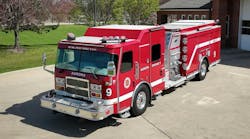For many departments across the country, the answer is being given to them by their insurance underwriters: Stop the upward accident rate spiral or lose your insurance coverage. There are too many competent and professional apparatus drivers who come to work, do their jobs and go home to allow a few “cowboys” to paint the entire cadre with the same brush. Not all apparatus drivers drink alcohol or ingest drugs before they drive. Not all apparatus drivers discount physics and push their rigs to speeds from which they cannot recover. Not all apparatus drivers put their crews at risk for little or no gain.
Too many fire chiefs jump on the training or discipline bandwagons to solve the problem, but I believe the problem is far more complex.
Anyone who has responded to an accident involving emergency apparatus will agree that when it’s bad, it’s really bad. Very rare, however, is the apparatus accident that could not have been prevented. Most often, the key factors are responding at speeds exceeding the posted limit, varying from normal traffic patterns, ignoring red lights or stop signs, driver inexperience or culture.
Must We Speed?
Many fire service stakeholders will point to training as the answer, but what kind of training do you need? I’ve received requests for skid pads to let drivers practice handling rigs at high speeds to gain confidence. The answer to that is, why do we need to speed at all? Even though water tanks on fire service tanker trucks are equipped with baffles, the effect of physics on a rig traveling at excessive speed with water inside has been proven: it’s much easier to lose control and even harder to panic stop. Research has concluded that we gain approximately 40 seconds by using lights and sirens. A test may be to send two pieces of equipment to the same address. One should respond with lights and sirens and one should proceed at normal traffic speed, and time the difference times. You may be amazed at the findings. Here’s another test: Take the pulse and blood pressure of each member of both crews. Again, you may be surprised by the findings.
Why are we responding with lights and sirens to all calls anyway? Is that eight-by-eight-foot, single-story steel structure really worth risking the lives of your crews? I think not. How about that automatic fire alarm after business hours at a high-rise building? Or that grass fire in a highway median strip? Many proactive fire departments have adopted tiered response policies. This involves assessing the need for lights and sirens on every call. It’s also known as risk management.
Apparatus drivers should be given one simple directive: “Drive as fast as you can stop.” This may seem confusing, but it’s really quite simple. The speed of a responding vehicle and its corresponding stopping distance can be correlated to the safety of the members onboard. If we look at our history for the answer, we will find that in the 18th and 19th centuries the first-arriving fire units that raised a ladder to the building or applied the first water stream were the ones paid by insurance companies. The horses were whipped and the men driven to get there first. Often, fist fights erupted between units.
I’m sure that’s not what is motivating the behaviors today – or is it? One danger associated with steadfastly clinging to tradition is that sometimes traditions outlive their usefulness or worthiness.
Another myth in apparatus driving is the right-of-way issue. Major manufacturers of cars and other personal vehicles tout their products as being soundproof. Even with the use of air horns and sirens, the other drivers may not hear your apparatus coming. This will really get ugly if you respond the wrong way down a one-way street and come upon an intersection. The other drivers will never expect you.
When apparatus drivers enter opposing lanes of traffic and “challenge” oncoming traffic, what risks are they putting on the members of their companies? Is that risk assumption valid? This type of behavior often depends heavily on the condition of all of the safety systems on the apparatus and their ability to function properly.
Let’s address the issue of discipline. Any driver who gets into a fire department vehicle or responds to a call in their private vehicle after drinking alcohol or taking drugs needs to be terminated for the first offense, period. If your department has standard operating procedures (SOPs) or standard operating guidelines (SOGs) for backing apparatus and these are violated, serious penalties should be levied for the driver and those in charge of the apparatus. If a driver develops a history of lopping off mirrors, perhaps behavior modification will alter their belief that the faster a vehicle goes, the more aerodynamic it becomes. Our fire service vehicles are getting wider, longer and higher while our city streets remain the same size.
Weather also poses significant challenges for the apparatus driver. You may think that adverse weather conditions would cause an apparatus driver to slow down to meet the challenge. This is referred to as “common sense.” I’ve been told over and over that “seconds count,” and that axiom is what drives us to forgo crew safety in all weather. If your vehicle slides off the road or into something, should the driver be held accountable for not putting the crew on scene to save the lives of those lost?
Put Firefighters First
How can we stop this hemorrhaging of lives, money and vehicles? First, we need to protect our people while responding. Every apparatus driver needs to put the lives of those onboard at a high enough priority to dictate how the rig is handled. Next, never take an intersection for granted. They no longer belong to us by virtue of lights and sirens because of the soundproof compartments contained in the other vehicles. All it takes is to stop and look – it’s worth the extra one or two seconds.
Drivers should know where they are going so they don’t need speed to make up for being unprepared. Survey the alleys, streets and roadways in your response area to ascertain where your apparatus will fit smoothly or not at all, or will be extremely tight.
We will continue to kill our own and civilians as long as we accept that speed is essential to all aspects of this thing that we do. Slow down. Stay safe!
Michael L. Smith, a Firehouse® contributing editor, is a retired deputy chief of the District of Columbia Fire Department, where he was chief of training. With over 35 years fire service experience, including more than 30 with DCFD, he is currently working as an international consultant and instructor for the fire service and U.S. military on incident command, training, risk management and weapons of mass destruction (WMD) response. Smith is a graduate of the Executive Fire Officer Program at the National Fire Academy and a Certified Municipal Manager (CMM) from George Washington University. He holds degrees in fire science, construction management and public administration.




